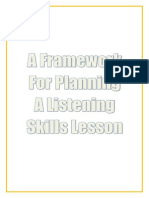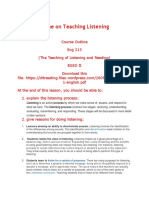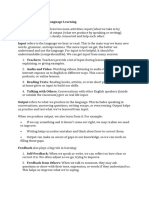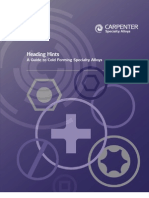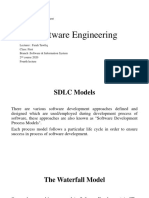Note For Unit 3 Mod 2 - 180 Hour
Uploaded by
SAJID ANWARNote For Unit 3 Mod 2 - 180 Hour
Uploaded by
SAJID ANWARIn this article I intend to outline a framework that can be used to design a listening lesson as
indicated in your assignment task that will develop your students' listening skills and look at
some of the issues involved.
The basic framework
Pre-listening
While listening
Post-listening
Applying the framework to a song here as an example
Some conclusions
The basic framework
The basic framework on which you can construct a listening lesson can be divided into three
main stages.
Pre-listening, during which we help our students prepare to listen.
While listening, during which we help to focus their attention on the listening text
and guide the development of their understanding of it.
Post-listening, during which we help our students integrate what they have learnt
from the text into their existing knowledge.
Pre-listening
There are certain goals that should be achieved before students attempt to listen to any text.
These are motivation, contextualisation, and preparation.
Motivation
It is enormously important that before listening students are motivated to listen, so you
should try to select a text that they will find interesting and then design tasks that will arouse
your students' interest and curiosity.
Contextualisation
When we listen in our everyday lives we hear language within its natural environment, and
that environment gives us a huge amount of information about the linguistic content we are
likely to hear. Listening to a tape recording in a classroom is a very unnatural process. The
A Reference Note for Unit 3 Module 2 180 Hours
text has been taken from its original environment and we need to design tasks that will help
students to contextualise the listening and access their existing knowledge and expectations
to help them understand the text.
Preparation
To do the task we set students while they listen there could be specific vocabulary or
expressions that students will need. It's vital that we cover this before they start to listen as
we want the challenge within the lesson to be an act of listening not of understanding what
they have to do.
While listening
When we listen to something in our everyday lives we do so for a reason. Students too need
a reason to listen that will focus their attention. For our students to really develop their
listening skills they will need to listen a number of times - three or four usually works
quite well - as I've found that the first time many students listen to a text they are nervous
and have to tune in to accents and the speed at which the people are speaking.
Ideally the listening tasks we design for them should guide them through the text and
should be graded so that the first listening task they do is quite easy and helps them to get a
general understanding of the text. Sometimes a single question at this stage will be enough,
not putting the students under too much pressure.
The second listening task for the second time students listen should demand a greater and
more detailed understanding of the text. Make sure though that the task doesn't demand
too much of a response. Writing long responses as they listen can be very demanding and is
a separate skill in itself, so keep the tasks to single words, ticking or some sort of graphical
response.
The third listening task could just be a matter of checking their own answers from the
second task or could lead students towards some more subtle interpretations of the text.
Listening to a foreign language is a very intensive and demanding activity and for this reason
I think it's very important that students should have 'breathing' or 'thinking' space between
listenings. I usually get my students to compare their answers between listenings as this
gives them the chance not only to have a break from the listening, but also to check their
understanding with a peer and so reconsider before listening again.
Post-listening
There are two common forms that post-listening tasks can take. These are reactions to the
content of the text, and analysis of the linguistic features used to express the content.
Reaction to the text
Of these two I find that tasks that focus students reaction to the content are most important.
Again this is something that we naturally do in our everyday lives. Because we listen for a
A Reference Note for Unit 3 Module 2 180 Hours
reason, there is generally a following reaction. This could be discussion as a response to what
we've heard - do they agree or disagree or even believe what they have heard? - or it could
be some kind of reuse of the information they have heard.
Analysis of language
The second of these two post-listening task types involves focusing students on linguistic
features of the text. This is important in terms of developing their knowledge of language,
but less so in terms of developing students' listening skills. It could take the form of an
analysis of verb forms from a script of the listening text or vocabulary or collocation work.
This is a good time to do form focused work as the students have already developed an
understanding of the text and so will find dealing with the forms that express those
meanings much easier.
Applying the framework to a song
Here is an example of how you could use this framework to exploit a song:
Pre-listening
o Students brainstorm kinds of songs
o Students describe one of their favourite songs and what they like about it
o Students predict some word or expressions that might be in a love song
While listening
o Students listen and decide if the song is happy or sad
o Students listen again and order the lines or verses of the song
o Students listen again to check their answers or read a summary of the song
with errors in and correct them.
Post-listening
o Focus on content
Discuss what they liked / didn't like about the song
Decide whether they would buy it / who they would buy it for
Write a review of the song for a newspaper or website
Write another verse for the song
o Focus on form
Students look at the lyrics from the song and identify the verb forms
Students find new words in the song and find out what they mean
Students make notes of common collocations within the song
A Reference Note for Unit 3 Module 2 180 Hours
Conclusion
Within this article I have tried to describe a framework for listening development that could
be applied to any listening text. This isn't the only way to develop our students listening or
to structure a listening lesson, but it is a way that I have found to be effective and motivating
for my students.
In order to exploit texts (spoken and written) properly I recommend using the
following plan:
1. pre-question to generate interest in the upcoming text
2- pre-teaching some of the vocabulary in the text in order to facilitate
comprehension
3- set a focus question before students read/listen for the first time
4- extensive listening/reading for gist (e.g. true false questions)
5- intensive listening for detail and finer meaning (multiple choice, gap fill exercise …)
6- Post-listening cycle (language focus (vocabulary/grammar), debate, discussion,
writing, …)
A Reference Note for Unit 3 Module 2 180 Hours
You might also like
- A framework for planning a listening skills lessonNo ratings yetA framework for planning a listening skills lesson3 pages
- A Framework For Planning A Listening Skills LessonNo ratings yetA Framework For Planning A Listening Skills Lesson10 pages
- A Framework For Planning A Listening Skills LessonNo ratings yetA Framework For Planning A Listening Skills Lesson3 pages
- Framework For Planning A Listening Skills LessNo ratings yetFramework For Planning A Listening Skills Less4 pages
- Module 12: Receptive Skills - Teaching Listening: Remember: Integration of Skills Is Paramount!No ratings yetModule 12: Receptive Skills - Teaching Listening: Remember: Integration of Skills Is Paramount!7 pages
- Phase 3.1 Teaching Techniques (Language Skills)No ratings yetPhase 3.1 Teaching Techniques (Language Skills)60 pages
- 7 Types of Activities For Listening With A PurposeNo ratings yet7 Types of Activities For Listening With A Purpose16 pages
- LECTURE 11 Intercultural Speech - Activity Bases of Communication On The Basis of Listening Plan - 1No ratings yetLECTURE 11 Intercultural Speech - Activity Bases of Communication On The Basis of Listening Plan - 116 pages
- Lesson Planning A Lesson Plan On Listening Skills: Level: Topic: AimsNo ratings yetLesson Planning A Lesson Plan On Listening Skills: Level: Topic: Aims18 pages
- Unit 3: The Teaching and Learning of EFL Listening and Reading100% (1)Unit 3: The Teaching and Learning of EFL Listening and Reading21 pages
- Teaching Listening Reasons For ListeningNo ratings yetTeaching Listening Reasons For Listening24 pages
- Methods of Learning and Teaching Lexis 2No ratings yetMethods of Learning and Teaching Lexis 238 pages
- 3 R Eceptive Skills: Reading: How Can You Help Your Students Improve Their Reading?No ratings yet3 R Eceptive Skills: Reading: How Can You Help Your Students Improve Their Reading?5 pages
- Reading & Listening Activities: Module SummaryNo ratings yetReading & Listening Activities: Module Summary2 pages
- A Framework For Planning A Listening Skills LessonNo ratings yetA Framework For Planning A Listening Skills Lesson12 pages
- Course Outline On Teaching Listening andNo ratings yetCourse Outline On Teaching Listening and23 pages
- Receptive Language Skills Learning and Teaching: Listening and ReadingNo ratings yetReceptive Language Skills Learning and Teaching: Listening and Reading4 pages
- Improving The Teaching of Listening: AbstractNo ratings yetImproving The Teaching of Listening: Abstract4 pages
- Week 4 Quiz: Differential Calculus: Uses of The Derivative: Increasing and Decreasing FunctionsNo ratings yetWeek 4 Quiz: Differential Calculus: Uses of The Derivative: Increasing and Decreasing Functions7 pages
- Influence: Science and Practice by Robert CialdiniNo ratings yetInfluence: Science and Practice by Robert Cialdini12 pages
- Badri Engineering Corporation: One Stop Shop For All Your Industrial NeedsNo ratings yetBadri Engineering Corporation: One Stop Shop For All Your Industrial Needs2 pages
- Blending Aggregate Stockpiles: Senior/Graduate HMA CourseNo ratings yetBlending Aggregate Stockpiles: Senior/Graduate HMA Course17 pages
- Customs and Traditions Listening While Watching100% (2)Customs and Traditions Listening While Watching4 pages
- Literature Review On Small and Medium Scale Enterprises in Nigeria100% (1)Literature Review On Small and Medium Scale Enterprises in Nigeria4 pages
- Software Engineering: University of Technology Computer Science DepartmentNo ratings yetSoftware Engineering: University of Technology Computer Science Department13 pages
- Ciara Della-Flora SHE (Technology's Influence On Psychological Mental Health)No ratings yetCiara Della-Flora SHE (Technology's Influence On Psychological Mental Health)3 pages
- First-Order Logic in Artificial IntelligenceNo ratings yetFirst-Order Logic in Artificial Intelligence38 pages
- Interpersonal Relationship:: Raja Abdul Rehman FA19-BBA-199No ratings yetInterpersonal Relationship:: Raja Abdul Rehman FA19-BBA-1993 pages
- Teaching English to Speakers of Other LanguagesFrom EverandTeaching English to Speakers of Other Languages
- A framework for planning a listening skills lessonA framework for planning a listening skills lesson
- A Framework For Planning A Listening Skills LessonA Framework For Planning A Listening Skills Lesson
- A Framework For Planning A Listening Skills LessonA Framework For Planning A Listening Skills Lesson
- Module 12: Receptive Skills - Teaching Listening: Remember: Integration of Skills Is Paramount!Module 12: Receptive Skills - Teaching Listening: Remember: Integration of Skills Is Paramount!
- 7 Types of Activities For Listening With A Purpose7 Types of Activities For Listening With A Purpose
- LECTURE 11 Intercultural Speech - Activity Bases of Communication On The Basis of Listening Plan - 1LECTURE 11 Intercultural Speech - Activity Bases of Communication On The Basis of Listening Plan - 1
- Lesson Planning A Lesson Plan On Listening Skills: Level: Topic: AimsLesson Planning A Lesson Plan On Listening Skills: Level: Topic: Aims
- Unit 3: The Teaching and Learning of EFL Listening and ReadingUnit 3: The Teaching and Learning of EFL Listening and Reading
- 3 R Eceptive Skills: Reading: How Can You Help Your Students Improve Their Reading?3 R Eceptive Skills: Reading: How Can You Help Your Students Improve Their Reading?
- A Framework For Planning A Listening Skills LessonA Framework For Planning A Listening Skills Lesson
- Receptive Language Skills Learning and Teaching: Listening and ReadingReceptive Language Skills Learning and Teaching: Listening and Reading
- Week 4 Quiz: Differential Calculus: Uses of The Derivative: Increasing and Decreasing FunctionsWeek 4 Quiz: Differential Calculus: Uses of The Derivative: Increasing and Decreasing Functions
- Influence: Science and Practice by Robert CialdiniInfluence: Science and Practice by Robert Cialdini
- Badri Engineering Corporation: One Stop Shop For All Your Industrial NeedsBadri Engineering Corporation: One Stop Shop For All Your Industrial Needs
- Blending Aggregate Stockpiles: Senior/Graduate HMA CourseBlending Aggregate Stockpiles: Senior/Graduate HMA Course
- Literature Review On Small and Medium Scale Enterprises in NigeriaLiterature Review On Small and Medium Scale Enterprises in Nigeria
- Software Engineering: University of Technology Computer Science DepartmentSoftware Engineering: University of Technology Computer Science Department
- Ciara Della-Flora SHE (Technology's Influence On Psychological Mental Health)Ciara Della-Flora SHE (Technology's Influence On Psychological Mental Health)
- Interpersonal Relationship:: Raja Abdul Rehman FA19-BBA-199Interpersonal Relationship:: Raja Abdul Rehman FA19-BBA-199















































